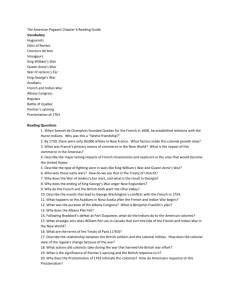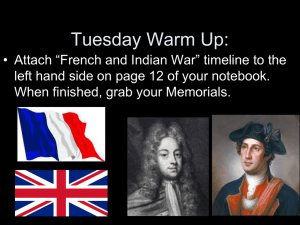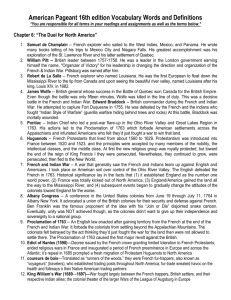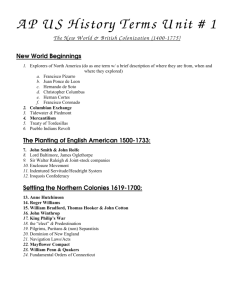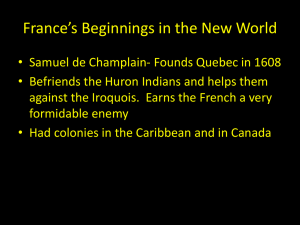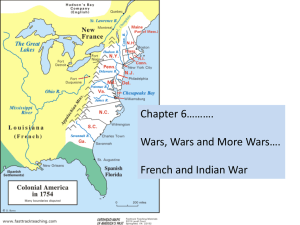Chapter 6
advertisement
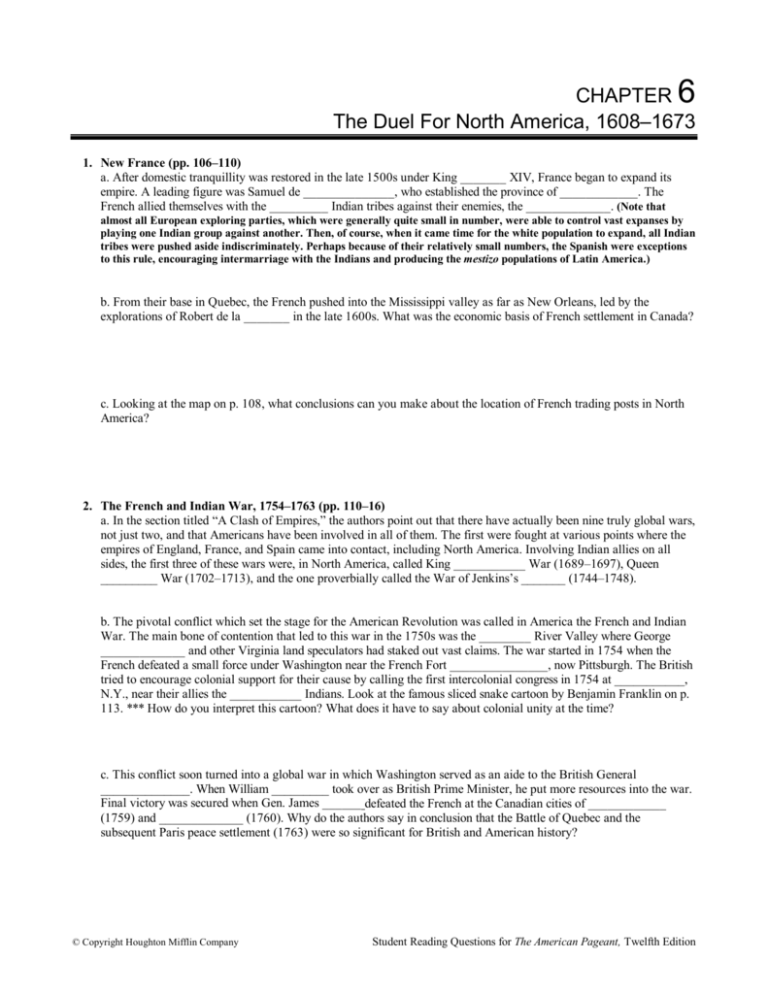
6 CHAPTER The Duel For North America, 1608–1673 1. New France (pp. 106–110) a. After domestic tranquillity was restored in the late 1500s under King _______ XIV, France began to expand its empire. A leading figure was Samuel de ______________, who established the province of ____________. The French allied themselves with the _________ Indian tribes against their enemies, the _____________. (Note that almost all European exploring parties, which were generally quite small in number, were able to control vast expanses by playing one Indian group against another. Then, of course, when it came time for the white population to expand, all Indian tribes were pushed aside indiscriminately. Perhaps because of their relatively small numbers, the Spanish were exceptions to this rule, encouraging intermarriage with the Indians and producing the mestizo populations of Latin America.) b. From their base in Quebec, the French pushed into the Mississippi valley as far as New Orleans, led by the explorations of Robert de la _______ in the late 1600s. What was the economic basis of French settlement in Canada? c. Looking at the map on p. 108, what conclusions can you make about the location of French trading posts in North America? 2. The French and Indian War, 1754–1763 (pp. 110–16) a. In the section titled “A Clash of Empires,” the authors point out that there have actually been nine truly global wars, not just two, and that Americans have been involved in all of them. The first were fought at various points where the empires of England, France, and Spain came into contact, including North America. Involving Indian allies on all sides, the first three of these wars were, in North America, called King ___________ War (1689–1697), Queen _________ War (1702–1713), and the one proverbially called the War of Jenkins’s _______ (1744–1748). b. The pivotal conflict which set the stage for the American Revolution was called in America the French and Indian War. The main bone of contention that led to this war in the 1750s was the ________ River Valley where George _____________ and other Virginia land speculators had staked out vast claims. The war started in 1754 when the French defeated a small force under Washington near the French Fort _______________, now Pittsburgh. The British tried to encourage colonial support for their cause by calling the first intercolonial congress in 1754 at ___________, N.Y., near their allies the ___________ Indians. Look at the famous sliced snake cartoon by Benjamin Franklin on p. 113. *** How do you interpret this cartoon? What does it have to say about colonial unity at the time? c. This conflict soon turned into a global war in which Washington served as an aide to the British General ______________. When William _________ took over as British Prime Minister, he put more resources into the war. Final victory was secured when Gen. James ______ defeated the French at the Canadian cities of ____________ (1759) and _____________ (1760). Why do the authors say in conclusion that the Battle of Quebec and the subsequent Paris peace settlement (1763) were so significant for British and American history? © Copyright Houghton Mifflin Company Student Reading Questions for The American Pageant, Twelfth Edition 3. Consequences of the French and Indian War (pp. 116–121) a. The two maps on p. 116 summarize well the changed areas of imperial control in North America as a result of the 1763 peace settlement. Summarize the main features of this changed power structure. (l) Before 1754: (2) After 1763: b. What do the authors believe the war did to the cause of greater unity among the colonies and to the sympathetic understanding between the British and the colonials? (1) Unity: (2) Sympathy/Understanding: c. What do the authors mean in the concluding section when they say that “with the French hawk killed, the colonial chicks had the confidence to range far afield”? d. After the British solidified their position in the Ohio Valley by defeating a united group of Indians under the Ottawa chief __________, the colonials felt they had a free rein to expand beyond the ____________ Mountains. Just then, the British issued the infamous Proclamation of 1763. What did this proclamation proclaim? e. Why did the British issue this proclamation and how was it interpreted (or misinterpreted) by the Americans? (1) British Reasoning: (2) American Intepretation: 4. The French in America (pp. 118–119) Look back at the first two paragraphs of this insert section. What is the interesting connection the authors make here between French settlement on the islands north of Maine (“Acadia”) and the current unique “cajun” culture of Louisiana? © Copyright Houghton Mifflin Company Student Reading Questions for The American Pageant, Twelfth Edition CHAPTER 6 TERM SHEET The Duel for North America Pages 106–110 French Huguenots Quebec Samuel de Champlain Huron Indians Iroquois tribes Robert de La Salle Pages 110–116 King William’s War Queen Anne’s War Treaty of Utrecht (1713) Acadia War of Jenkin’s Ear (1739) George Washington Fort Duquesne Fort Necessity (1754) French and Indian/Seven Years War (1754–1763) Albany Congress (1754) Gen. Edward Braddock William Pitt Louisbourg (1758) Gen. James Wolfe Quebec (1759)/Montreal (1760) Peace of Paris (1763) Pages 116–1621 Chief Pontiac’s War (1763) Daniel Boone Proclamation of 1763 © Copyright Houghton Mifflin Company Student Reading Questions for The American Pageant, Twelfth Edition



